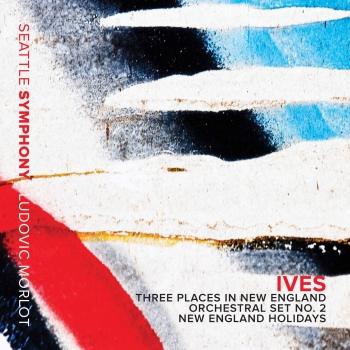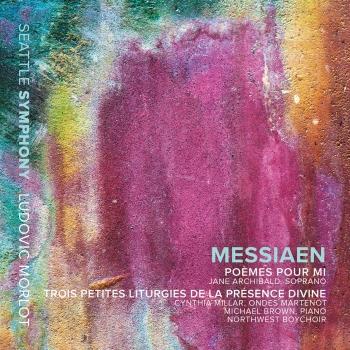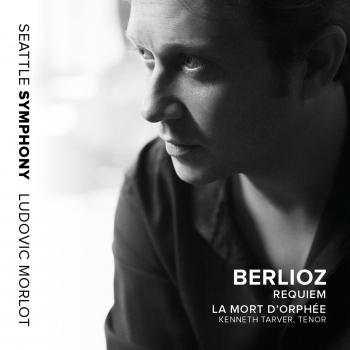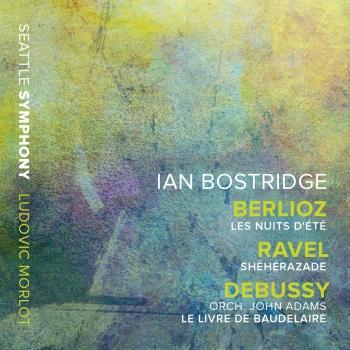
Stravinsky: Petrushka - Debussy: La boîte à joujoux, L. 128 Seattle Symphony Orchestra & Ludovic Morlot
Album info
Album-Release:
2016
HRA-Release:
10.06.2016
Label: Seattle Symphony Media
Genre: Classical
Subgenre: Orchestral
Artist: Seattle Symphony Orchestra & Ludovic Morlot
Composer: Igor Stravinsky (1882-1971), Claude Debussy (1862-1918)
Album including Album cover Booklet (PDF)
- Igor Stravinsky (1882 - 1971): Petrushka:
- 1Tableau I: The Shrovetide Fair10:19
- 2Tableau II: Petrushka's Room04:32
- 3Tableau III: The Moor's Room06:56
- 4Tableau IV: The Shrove-Tide Fair and the Death of Petrushka14:08
- Claude Debussy (1862 - 1918): La boîte à joujoux:
- 5Prelude: Le sommeil de la boite (The Toy-box Asleep)02:20
- 6Tableau 1: Le magasin de jouets (The Toy Shop)10:53
- 7Tableau 2: Le champ de bataille (The Field of Battle)09:38
- 8Tableau 3: La bergerie a vendre (The Sheepfold for Sale)06:29
- 9Tableau 4: Apres fortune faite (After Making a Fortune)01:49
- 10Epilogue01:20
Info for Stravinsky: Petrushka - Debussy: La boîte à joujoux, L. 128
The theme of the disc is a celebration of children’s play and features a live Recording of Stravinsky’s 'Petrushka', as well as a studio recording of Debussy’s rarely recorded 'La boîte à joujoux' (“The Toy Box”).
Petrushka: During the second decade of the 20th century, Paris emerged as a singularly important city for music in general, and more particularly as the birthplace of the remarkable new style of musical invention we have come to call modernism. This last was pioneered by French composers (Debussy, Ravel and Satie chief among them), as well as by emigres recently arrived in the city. Of the latter, the most important was a Russian, Igor Stravinsky, who first came from Saint Petersburg in 1909 and soon would make Paris the center of his creative activity.
Not the least of the modernist innovations that reshaped music in France at this time was the elevation of the ballet score as the vehicle for the most ambitious compositional thinking. The other major orchestral genres, the symphony and concerto, seemed to many of the composers working in Paris at this time, too freighted with tradition, especially that of Austro-German classicism. Ballet music offered greater freedom to explore new melodic, harmonic and rhythmic ideas, and for new formulations of instrumental color.
La boîte à joujoux: In 1913, André Helle, an artist who specialized in writing and illustrating children’s books, approached Claude Debussy with the idea of turning one of his stories, La boîte à joujoux (“The Toy Box”), into a ballet. Debussy was taken with this notion, and in the summer of that year began writing music for such a piece, proceeding, he told his publisher, by “extracting secrets from [his daughter’s] old dolls.” Notwithstanding whatever help those toys may have rendered, composition of the work proved di cult, and in late September the score still was not finished. “The soul of the doll is more mysterious than [one] imagines,” Debussy wrote, “and does not easily put up with the claptrap that so many humans tolerate.” Finally, by the end of October, a piano draft of the work was finished.
Various diffculties, not least being the outbreak of World War I, prevented the mounting of a ballet production, and Debussy worked at orchestrating his piano score only intermittently during the next three years. By the second half of 1917 he was too ill to continue, and he died in March of the following year, the ballet’s instrumentation still not finished. Its completion fell to Debussy’s friend, the composer and conductor André Caplet, who accomplished the task with such skill that it is impossible to distinguish his contribution from Debussy’s. La boîte à joujoux was rst performed as a ballet in December 1919, in Paris. Although it has received few choreographic presentations, the score makes a ne concert piece, Debussy’s allusive harmonies and iridescent orchestration working their usual magic.
Seattle Symphony Orchestra
Ludovic Morlot, conductor

 Seattle Symphony Orchestra
Seattle Symphony Orchestra
under the leadership of Music Director Ludovic Morlot, is a vital part of the Pacific Northwest cultural scene and is recognized for its extraordinary performances, programming, recordings and community engagement. With a dedicated subscriber base of more than 25,000 patrons, the Symphony performs or presents over 200 performances annually to an audience of more than 290,000 people.
Since its first performance on December 29, 1903, the Seattle Symphony has held a unique place in the world of symphonic music. During its formative years, it was the charismatic Sir Thomas Beecham who most developed the Orchestra's skill and reputation. In 1954 Milton Katims began his 22-year tenure as Music Director, greatly expanding the Symphony's education programs. Rainer Miedél, Music Director from 1976 until his death in 1983, led the Orchestra on its first European tour in 1980. Gerard Schwarz was appointed Music Advisor in 1983, and Music Director in 1985. During his 26-year tenure, the Seattle Symphony made more than 140 recordings and garnered 12 Grammy nominations and two Emmy Awards.
The Orchestra is now under the artistic leadership of Ludovic Morlot, one of the leading conductors of his generation. During 2011–2012, Morlot’s inaugural season, the Symphony enjoyed critical acclaim for its blockbuster performances of Stravinsky’s The Rite of Spring, Berlioz’s The Damnation of Faust, and Hols’s The Planets; the inaugural presentation of Sonic Evolution, a commissioning project designed by Morlot to feature new works honoring Seattle’s musical heritage; and a season-long exploration of the music of French composer Henri Dutilleux. Morlot’s second season, 2012–2013, was marked with further critical success, including sell-out performances of Britten’s War Requiem, RachFest, an immensely popular cycle of Rachmaninov’s Piano Concertos, and the Seattle Symphony’s first-ever performance of Messiaen’s Turangalîla.
In 1998 the Seattle Symphony inaugurated its new home, Benaroya Hall, noted for its architectural and acoustical splendor. Three years later, the Orchestra opened Soundbridge Seattle Symphony Music Discovery Center, where people of all ages explore the world of symphonic music through exhibits, classes and live music presentations. The Symphony’s education programs, alongside its nationally recognized community engagement programs, bring classical music to nearly 50,000 people of all ages each year.
Ludovic Morlot
As the Seattle Symphony’s Music Director, Ludovic Morlot has been received with extraordinary enthusiasm by musicians and audiences alike, who have praised him for his deeply musical interpretations, his innovative programming and his focus on community collaboration. Morlot is also Chief Conductor of La Monnaie, one of Europe’s most important opera houses.
In the U.S. Morlot has conducted the Boston Symphony Orchestra, Chicago Symphony Orchestra, Los Angeles Philharmonic, New York Philharmonic, Philadelphia Orchestra and Pittsburgh Symphony. Additionally, he has conducted the BBC Scottish Symphony Orchestra, Czech Philharmonic, Dresden Staatskapelle, Israel Philharmonic, Montreal Symphony Orchestra, Orchestre National de France, Royal Concertgebouw Orchestra, Rundfunk- Sinfonieorchester Berlin, Saito-Kinen Festival Orchestra and Tonhalle Orchestra (Zürich).
Trained as a violinist, Morlot studied conducting at the Royal Academy of Music in London and then at the Royal College of Music as recipient of the Norman del Mar Conducting Fellowship. Morlot was elected an Associate of the Royal Academy of Music in 2007 in recognition of his significant contributions to music. He is Chair of Orchestral Conducting Studies at the University of Washington School of Music.
" class="ng-binding ng-scope">Seattle Symphony Orchestra, Ludovic Morlot

























